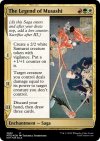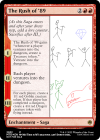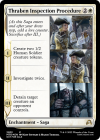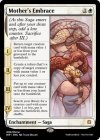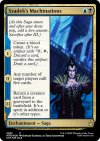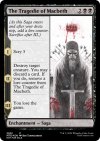7000 years ago, an alchemist named Edgar Markov had an issue to solve. He had lived a life barely scraping by in the minor territory of Stensia. His family could not continue if something were to happen to his only grandson, Sorin. So, Edgar began to look for a way to solve the issue. At first, he experimented with ways to increase crop yield, to ensure a bright future for what remained of his family.
Before Edgar could finish his work, a great famine struck Stensia. Desparate to try and avoid starvation, Edgar began experimentation with Blood on the suggestion of Shilgengar, an ancient archdemon. Edgar tried multiple different blood formulas in an attempt to solve the famine. Eventually, he had but one final source of power to exploit: the blood of an angel.
Edgar captured the angel Marycz in his laboratory and drained her blood. He used the power from within her veins as part of a ritual to finally secure his family's place in the world. Marycz's contribution was the most important: for drinking her blood would complete the transformation. Edgar took the first sip. As the angel's coppery blood drizzled across his tongue, Edgar became an ageless Vampire. Now able to drink the blood of Humans for sustinance, the Markovs were finally able to avoid starvation. They would need this skill– a side effect of the blood rite was immortality! The blood rite to induce Vampirism came at a toll of great agony. The pain was enough to ignite Sorin's latent Planeswalker spark, allowing him to travel the multiverse and potentially spread Edgar's gift to other worlds. Luckily, it seems Sorin used his grandfather's gift to do some good, but that's another story...
I chose to keep this card fairly simple. One of the reasons why cards like
Fable of the Mirror Breaker,
Okiba Reckoner Raid,
Binding the Old Gods, and
Showdown of the Skalds work so well as Sagas compared to other options is because they are all relatively simple.While they may have a lot of text compared to other Magic cards, they have clear and concise abilities that have multiple different unique lines of play.
I think Edgar's Sanguine Gift does a good job of telling it's story and having lots of cross-synergies that can provide several unique deckbuilding opportunities. It has artifacts for affinity and metalcraft decks, tokens for token strategies, discard outlets for reanimation, madness and cycling decks, lifelink for life gain strategies, and two supported subtypes for Vampires and Blood decks. Even if it's
not being leveraged for it's micro-synergies, the card has more than enough built-in value that a Midrange deck could play it as a grindy engine peice. In fact, this card would likely be played along side
Fable of the Mirror Breaker if it were legal in current standard, as that deck already leverages blood tokens for value. This brings me to my final point in the mechanical discussion of this card. Chapter 3 is worded in such a way so that sacrificing blood tokens through any method, not simply activating their ability, will cause the creation of a 2/3 vampire. So, if you're sacrificing blood to an
Oni-Cult Anvil or maybe something a little spicer like
Korvold, Fae-Cursed King, you can still get the value vampire.
From a lore point of view, I think the card tells the story of Edgar creating the first vampires exceedingly well. The first chapter shows Edgar's earlier experiments with immortality, the second chapter shows the "eureka" moment where he discovers blood as a source of power, and the third chapter shows the first vampires being created by drinking angel blood. It can even create exactly two Vampires by itself: Edgar and Sorin. Of course, someone with a dedicated Blood deck could create multiple Vampires off of the final trigger.
Will you lead the Markovs to Glory as Edgar did before?

